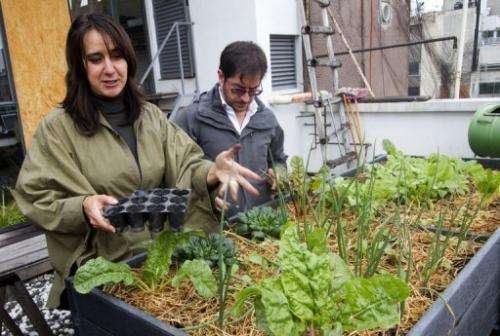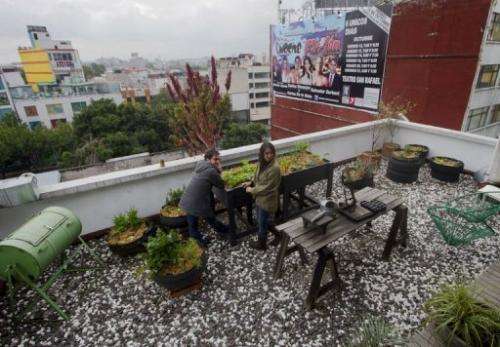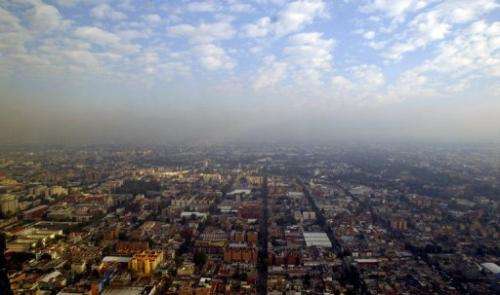Revolution in Mexico City, one lettuce at a time

A green revolution is sweeping across the car and concrete jungle of Mexico City, an infamously smoggy capital that was once dubbed "Makesicko City" by novelist Carlos Fuentes.
Residents are growing vegetables on rooftops, planting trees where buildings once stood, hopping on bicycles and riding in electric taxis, defying the urban landscape in this metropolis of 20 million people and four million cars.
"This is our vote for the environment," said Elias Cattan, a 33-year-old bespectacled architect pointing to the lettuce, onions and chilies growing in a planting table and inside used tires on the balcony of his rooftop office.
"It's a window to the future and it is very important that we reconnect with the earth," he said as light rain fell on the sprouts atop the five-story building in the trendy Condesa neighborhood.
Like a growing number of chilangos—as Mexico City residents are called—Cattan bikes to work in a maze of roads renowned for their giant traffic jams.
Twenty years ago, the United Nations declared the Mexican capital the world's most polluted city. Fuentes envisioned black acid rain in his novel "Christopher Unborn," but in real life the air was so nasty that birds dropped dead in this megalopolis 2,240 meters (7,350 feet) above sea level.
While Mexico City still has high levels of pollutants, it has dropped off the top 10 blacklist, thanks to traffic restrictions and the closure of factories but also because other cities have become grimier.
The left-wing city government has carried out a "green plan" since 2007 to clean up the capital, but many citizens have also taken it upon themselves to change their habits.
The city has placed 500,000 plants across the city, expanded a popular bicycle loan program, opened a new subway line and launched an "eco" bus that runs on natural gas.
Electric, zero-emission taxis began buzzing in the city center this year. The vehicles recharge in power stations that get 25 percent of their energy from solar panels. Fully powered up, the cabs can run for six hours straight.

One of the taxi drivers, Cristobal Reynoso, said clients often realize they are in an electricity-powered vehicle only once they are in it.
"It's a thrill when I tell them it's electric, that it doesn't use fuel or anti-freeze, that it doesn't have an exhaust pipe, because they say, 'we're not polluting!'" Reynoso said.

Citizens are playing their part too.
Many go to Chapultepec Park on the first Sunday of every month to trade their recyclables—empty bottles, paper, cardboard—for locally-grown produce such as tomatoes, corn and nopal (an edible cactus) in a city program.
A corporate-funded citizen initiative known as VerdMX has installed huge "vertical gardens" to spruce up the city and clean the air. One of its most visible structures is a green arch on the heavily-traveled Chapultepec Avenue.
Growing plants, fruits and vegetables here requires creativity and lessons. The city and private groups offer advice to those who want to learn how to plant in a building.
"It's easy, fun and cheap," said Liliana Balcazar, deputy director of the city's environmental education centers that show people urban gardening tricks. "You can do it anywhere that gets at least five to six hours of sun per day."
"It's like being in the countryside inside the city," Balcazar said, noting that it is also a great source of healthy, home-grown produce for a population facing an obesity problem.
Cattan has received help from Gabriela Vargas, a 43-year-old former photographer whose passion was born 12 years ago, when she planted vegetables in her balcony to make tastier, healthier food for her daughter.
"When I started 12 years ago, I was the crazy one growing lettuce in her apartment. Now it's very common," said Vargas, project director for Cultiva Ciudad (Cultivate City), which advises schools, individuals and institutions.
Vargas now sees bigger: She plants trees.
Last year, her organization donated 6,000 trees to various city districts that were grown inside the city.
Her new project is an orchard where she will grow apple, guava, peach and medlar trees. The city is lending her a 1,650-square-meter (17,800-square-foot) terrain where a high-rise building was demolished.
While the city is getting greener, the smog is still visible, often clouding the surrounding mountain peaks.
Though carbon monoxide levels are down by 90 percent from 20 years ago, the city still has above recommended levels of ozone and suspended particulates, another pollutant.
"The good news is that the trend has been a consistent reduction (of ozone) in the last 10 years," said Armando Retama, director of the city's air quality monitoring service. "If the trend holds, Mexico City's contamination problem will be almost resolved in 10 years."
(c) 2012 AFP

















